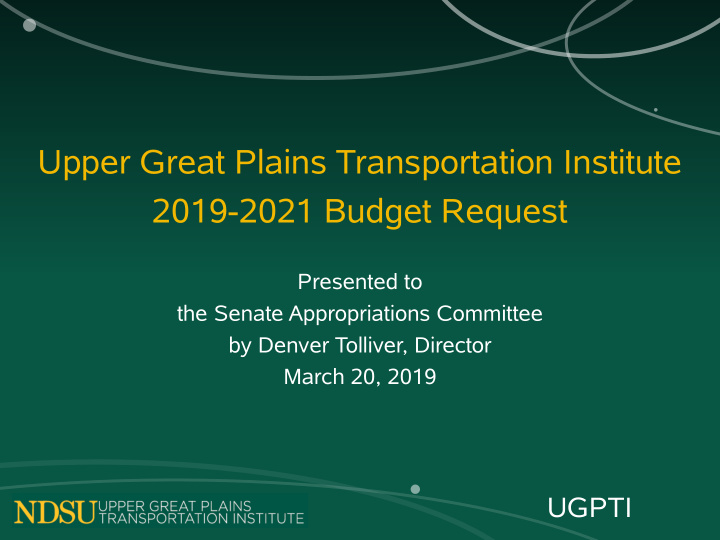



Upper Great Plains Transportation Institute 2019-2021 Budget Request Presented to the Senate Appropriations Committee by Denver Tolliver, Director March 20, 2019 UGPTI
Contents • Major components comprising the "base level" amounts of UGPTI’s budget • Changes to base level made by House • SBHE and Advisory Council recommendations • UGPTI’s budget request to the Senate • Benefits of UGPTI’s program request pg . 2
UGPTI’s 2017-2019 Base Level Budget Line Item Amount Percent 1. General funds $3,443,174 15.5% 2. Special funds $6,338,850 28.5% 3. Federal funds $12,478,218 56.0% 4. All funding sources $22,260,242 100.0% pg . 3
2019-2021 Budget Passed by House Item Base Level Adjustment Appropriation Total all funds $22,060,242 $777,487 $22,837,729 Less est. income $18,617,068 $257,255 $18,874,323 General fund $3,443,174 $520,232 $3,963,406 FTE positions 43.88 0.00 43.88 pg . 4
Detailed Changes Made by House Adjustments or Enhancements Salary & Road & Total Benefit Misc. Bridge House Item Increases Expenses Study Changes Total all funds $398,350 ($70,863) $450,000 $777,487 Less est. income $257,255 $0 $0 $257,255 General fund $141,095 ($70,863) $450,000 $520,232 pg . 5
Recommendation of SBHE and UGPTI Advisory Council Item Amount Base level budget $3,443,174 County road & bridge center $975,000 Total general fund request $4,418,174 pg . 6
Economic Importance of County and Local Roads • County & township roads are heavily utilized for – Movements from farms to storage/transfer facilities – Crude oil movements from wells to pipeline and rail transfer facilities by truck – Inputs for oil and ag. production: often delivered by truck to dispersed production sites located off the state highway system • County and township roads are essential to the state’s rural economy pg . 7
Benefits of Road Investments • According to FHWA, average benefit/cost ratio from highway and bridge investment (considering all benefits) > 5.0 • B/C ratio > 2 for resurfacing low volume rural roads • Broader benefits to the economy are much greater – Reduction in total industry logistics costs – Multiplier effects from lower input prices pg . 8
Effect of Road Condition on Trucking Cost Road Present Serviceability Cost Condition Rating (PSR) Index Excellent 5 0.91 Good 4 0.93 Fair 3 1.00 Poor 2 1.14 Very Poor 1 1.26 Source: TRB Special Report 227 pg . 9
Effect of Road Condition on Maintenance Cost pg . 10
Impact of Deferring Road Investment Thickness PSR Cost/Mile Improvement (inches) Threshold ($000) Thin Overlay 2 2.5 $200 Structural Overlay 4 2.0 $375 Rehabilitation 1.8 $600-$1,000 Reconstruction < 1.8 $1,250 pg . 11
Biennial Condition/Needs Report • UGPTI will collect traffic data in partnership with NDDOT > 1,000 locations on county/local roads • Develop current estimates of surface conditions • Forecast truck traffic levels from economic activity in the state: specifically – Oil, produced water, drilling inputs – Crop production – Processing/manufacturing • Inputs used to predict resurfacing, rehabilitation, graveling and other maintenance needs pg . 12
History of UGPTI Studies • In 2012, 2014, and 2016 UGPTI provided the Legislature with reports of needed investments in county, township, tribal roads • Studies were financed with one-time appropriations • No funding was provided for a 2017-19 study • Latest traffic, road condition, and investment needs estimates are three years old pg . 13
UPGTI’s Traffic Model Truck trips predicted from and to each oil spacing unit, cropland section, and major processing plant → Predicted trips accumulated for road segments → Predicted trips compared to observed truck volumes on principal road segments → Model is calibrated against observed traffic levels in the base year pg . 14
Road Asset Management • Holistic approach that minimizes long-term cost and makes roads last longer under heavy traffic • Preserve road condition by applying the best treatment at the proper time • $1 spent on maintenance at the right time could save $4 to $5 in the future • Ultimate vision: all counties use same system – Generate consistent condition/performance measures – Ensure consistency/compatibility across counties – Avoid duplication of efforts and minimize cost pg . 15
Near-Term Objectives • Continue development of online Geographic Roadway Inventory (GRIT) and mapping tools • Already being used by many counties • Current information, available from all sources: – Roadway width, surface, type, etc. – Condition – Truck traffic – Construction history and improvements plans • Consistent data that can produce statewide performance measures pg . 16
Decision Support Tools • Surface selection (paved vs. aggregate surface) • Preservation treatment selection – Select from improvement types: thin overlay, structural overlay, rehabilitation, shoulder improvements, etc. – Maintenance treatments: e.g., chip seal, crack sealing, patching, microsurfacing – Unpaved roads: frequencies of blading, graveling, dust control, gravel depth pg . 17
Benefits of County Road/Bridge Program • ≈ 6,000 miles of paved county road in North Dakota • Should be resurfaced ideally when PSR reaches 2.5 • Without UGPTI’s biennial study, road investments could be pushed into the future • Deferring investment until rehab. increases capital cost by $400k to $1 million dollars per mile • If just one 5-mile segment is identified, improved in a timely manner, and rehab. is avoided, $2 million to $4 million can be saved. pg . 18
Benefits of County Road/Bridge Program (Continued) • Based on 2016 study, it is likely that 10% of paved county road-miles have PSR values > 2.5 • Another 14% have PSR values from 2.5 to < 3.0 • If investments in just 100 miles of these roads are optimized, UGPTI’s program will save the State $40 million to $80 million in capital costs • If investments in 500 miles of county road are optimized, UGPTI’s program will save the State $200 million to $400 million in capital costs pg . 19
Thank you! pg . 20
Recommend
More recommend